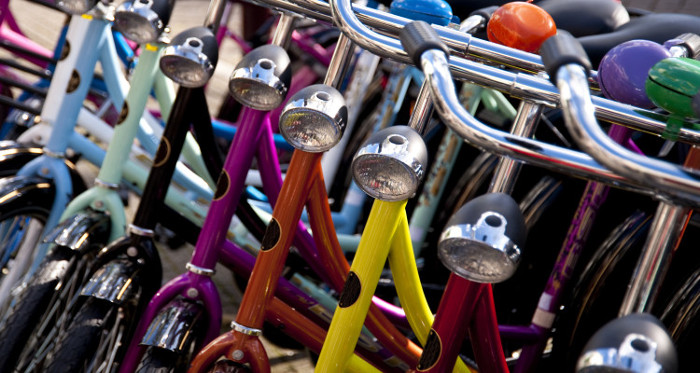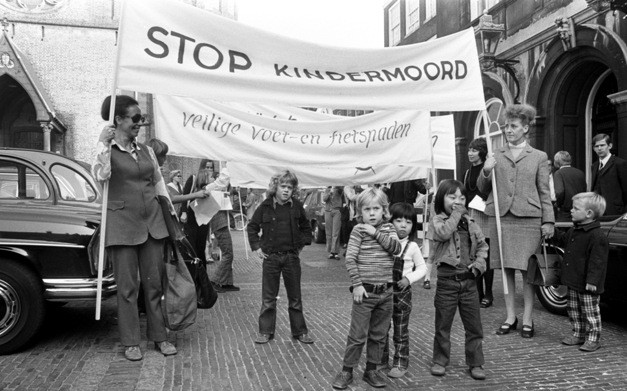The strange thing in the safest traffic country in the world
In the Netherlands and major cities such as Amsterdam and The Hague, the number of bicycles is even more than the number of people residing here and there is up to 70% of travel needs using this vehicle. So what makes people come back to bicycles?
Before World War II, travel in the Netherlands was mainly due to bicycles. But in the 1950s and 1960s, when the number of car owners skyrocketed, this changed. Like many other countries in Europe, the roads are becoming increasingly congested and cyclists are squeezed close to the curb.

Dutch people love to ride bicycles.
A sharp increase in the number of cars also caused a large increase in the number of traffic accident deaths. In 1971 alone, more than 3,000 people died from a car accident, and 450 victims were children.
In this situation, a social movement requires the creation of safer bike conditions for children. The movement called "Stop de Kindermoord" (Stop killing children) is taken from the title of an article by journalist Vic Langenhoff, whose child was killed by a traffic accident.
In addition, Dutch faith in the certainty and sustainability of motor vehicles was also shaken after the Middle East oil crisis in 1973, when oil-producing countries stopped exporting to the US and Europe. Europe.
These two pressures contributed to convincing the Dutch government to invest in improving bicycle infrastructure and urban planners in the Netherlands began to divert away from centralized road construction policies. for cars conducted during urbanization.

Movement "Stop de Kindermoord".
Road to glory
To help make cycling safer as well as attract more Dutch people to participate in building a wide network of bike paths. There are clear imprints, smooth road surfaces, separate signals and traffic lights reserved for two-wheeled vehicles and roads that are wide enough to drive on equal footing while other vehicles can still pass. up.
In many cities bike paths are completely separate from motorized traffic. Sometimes, in tight spaces and both vehicles have to share a road, you can see signs showing bicyclists with cars in the back with lines The word "Bicycle Street: Car is just a guest".

The sign means: "Bicycle street: cars are just guests".
Also, at the roundabouts, cyclists are always given priority.
You can ride a bike around the roundabout while cars (often) have to wait patiently for you to pass. The idea that "bike is always right" is a strange concept for bicycle travelers, and at first many people often find it difficult to navigate the roads and intersections.

At roundabout intersections, bicycles have their own roads and are often given priority over other vehicles.
Social platform into the education system
Even before they knew it, Dutch children lived in a world of bicycles. Babies and toddlers are often seated in special chairs on the "bakfiets" - 3-wheeled bicycles. These chairs are often equipped with a roof to protect children and some parents even spend a small amount of space to upgrade their facilities.

Babies are seated in special chairs on 3-wheeled bicycles.
As children get older, they will ride their own bicycles. This is quite easy and safe because bike lanes are wide enough for children to cycle with adults next door. And because those under 18 will not be allowed to drive without supervision, bicycles are the choice for the freedom of Dutch youth.
The state also plays a role in education with proficient biking lessons, a required part of the Dutch school program. All schools have bike storage and in some schools up to 90% of students go to school by bicycle.
Behind bicycle parking lots
At Groningen City University, the central station has an underground bike storage facility that can hold 10,000 cars. Cyclists also have the same parking facilities as motorcyclists elsewhere, with electronic gateways at each entrance indicating the number of vacant parking spaces in the yard.
Bicycle parking lots are very popular in the Netherlands - outside schools, office buildings and shops. However, the riders can only leave their vehicles at designated locations. Vehicles left in the wrong place will be transferred and confiscated and owners must pay a fine of more than 25 euros to bring the car back.
At the residence, even those who live in apartments without a garage are allowed to park their bicycles on the corridor.

Bicycle parking in Amsterdam style.
In the 16th century, houses in Amsterdam were taxed according to the width of the house. Residents oppose this calculation by building tall buildings and narrowing their houses. So the corridors are always full of bicycles, but since there are so many people riding bicycles, no one really bothered about this, and they simply climbed over them.
Bicycle - a symbol of sustainable love
In the Netherlands cycling is so popular that the people here do not like being called cyclists - " We are not cyclists, we are Dutch".
Bicycles are an indispensable part of everyday life, not an expert accessory or symbol of the lifestyle of a minority group, so the Dutch are not much interested in car models. Latest bike or high tech gadgets.
They consider bicycles to be reliable companions during the adventures of life. And in such a relationship, longevity is a matter of primary concern - the older the better. So it's not uncommon for you to hear the sound of a mudguard rubbing against the bike's wheel right behind you. It is not the poverty that old bikes have more symbolic meaning because it is a testament to a lasting and lasting love.

3 wheeled bicycle.
Cycling without sweat
The terrain in the Netherlands is famous for being flat with many densely populated areas. This means that most trips are less time-consuming and not too hard.
The Dutch often prefer cycling to work, to shops or pubs in whatever kind of outfit they think is suitable for their destination. Of course the roads here allow people to leisurely ride in cool summer outfits. Partly because of this, people do not need to bathe at the company every time they go to work on bicycles - it is the experience of cycling without sweat.
Dutch people also do not need to wear helmets because they are protected by bicycle rules on the road as well as road infrastructure designed for bicyclists. If you see someone wearing a helmet when riding a bike in the Netherlands, it is most likely a tourist or a professional cyclist.
Rights and responsibilities
The fact is that everyone is riding a bicycle, or getting to know someone on a bicycle, so this means that drivers are more sympathetic for cyclists when they join in traffic.
In contrast, cyclists also need to respect and obey traffic laws. You will be penalized if you drive carelessly, leave your car in the wrong position, or pass a red light. You will be fined 60 euros by the police (who usually ride a bike) if you do not turn on the lights in the evening and you will even have to pay a lot more for the lack of bikes mounted on the bike - usually quite a lot Dutch designation.
Of course, accidents still occur but in the case of cyclists, the insurance company will refer to Article 185 of the Dutch Road Safety Code, which regulates the so-called " responsibility ". absolute duty " , meaning that drivers will usually have to pay at least 50% of the costs for their cyclists and vehicles.
When participating in traffic, Dutch cyclists felt that they were powerful and protected. This makes the whole experience with the bike much more interesting. Although there are inevitably some dangerous problems on the road, it is rarely related to bulky trucks, inconvenient intersections or dangerous drivers.
- What factors helped Japan become the safest country in the world?
- Just choose to sit these places, the chances of survival will be highest
- Quickly see the secret of choosing a safe seat when the car is in distress
- America unveils the safest UAV model in the world
- Synchronize traffic lights to avoid traffic jams
- Detecting strange objects on Mars like traffic lights
- The safest place on earth to avoid nuclear disaster
- Not only in Vietnam, but also the rush hour in other countries
- Sneeze safest way?
- The idea of the new Chinese thought will be the solution for future traffic problems
- Self-driving cars will erase the concept of traffic jams, traffic jams
- What is the safest seat in the car?
 'Fine laughs' - Scary and painful torture in ancient times
'Fine laughs' - Scary and painful torture in ancient times The sequence of numbers 142857 of the Egyptian pyramids is known as the strangest number in the world - Why?
The sequence of numbers 142857 of the Egyptian pyramids is known as the strangest number in the world - Why? History of the iron
History of the iron What is alum?
What is alum?